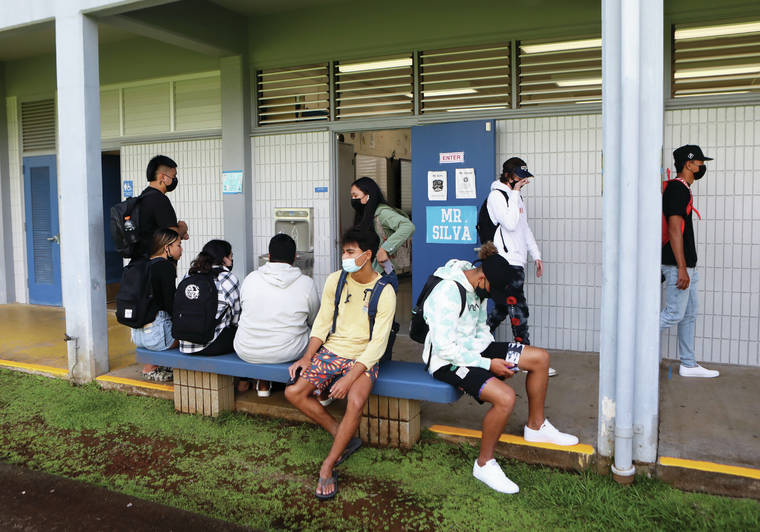Schools try to ‘stay the course’: COVID-19 cases creep up at DOE campuses statewide

Kelsey Walling/Tribune-Herald Students are shown on the first day of school at Waiakea High School on Aug. 3 in Hilo.
Coronavirus cases are climbing on school campuses across the state.
Coronavirus cases are climbing on school campuses across the state.
More than 50 COVID-19 cases were reported in Big Island schools and administrative offices Aug. 7-13, the first full week that most students returned to campuses.
ADVERTISING
They were among the 325 reported statewide Friday by the state Department of Education.
“The total case count is higher this week, but considering the size of our organization — more than 200,000 students and employees across the department — and the level of transmission occurring in the broader community, I think it’s a testament to our schools’ safety protocol that we saw 70 confirmed cases over the past week that had an impact to a HIDOE campus,” interim state Superintendent Keith Hayashi said in a news release Friday afternoon. “Although ideally we’d want no cases, it’s important to commend our schools for working diligently to minimize exposure and prevent the spread of COVID by enforcing the core essential strategies, including promoting vaccinations for all who are eligible.”
Among the cases reported on Big Island campuses, four were at Waiakea High School.
Principal Kelcy Koga said it was inevitable the school would have coronavirus cases, “and it happened.” He thinks the number of cases will rise over time but not necessarily because of exposure on campus.
“We’re trying as hard as we can for all of the kids to follow the mitigation requirements, but people come into contact with each other, and not everyone is vaccinated. It’s bound (to happen).”
According to Koga, the four cases at Waiakea High were isolated cases that came in from off campus. He was not aware of any instances in which students or employees have infected each other.
No additional students or faculty had to quarantine due to the identified cases.
“It doesn’t always begin or end on campus. It may come in from the outside,” he said. “… All we can do is stay the course and try to ensure some sense of social distancing, cleaning and disinfecting, washing of hands.”
But with an “alarming” number of COVID cases statewide — a surge driven by the highly transmissible Delta variant — Koga said he thinks it’s getting to the point where the DOE “possibly has to look at distance learning or temporarily shut down to get numbers back down.”
While the state did create a distance learning program that a handful of students officially entered, Koga said at least 90% of students at his school have been attending in-person classes.
“I know that for most of the students, they want to be in school, and they want to be here,” he said. “Nothing really takes the place of face-to-face learning. But a temporary shutdown might be the answer to get the numbers back down.”
Ka‘u-Keaau-Pahoa Complex Area Superintendent Chad Keone Farias said he wasn’t surprised to see cases in schools, but is proud of the schools for implementing their mitigation strategies.
But that’s not enough.
“I think we need a higher rate of vaccination in our community and (I) also can’t wait for the opportunity to offer the vaccine to our younger students. Then I think our mitigation strategies will be enough.”
Farias said it’s hard to pinpoint where cases in the complex area are coming from, but at this time they’re not seeing multiple cases in a particular classroom.
“I’m absolutely pleased that students are back,” he said.
“We’ve been back to some degree since January, (but) I’m alarmed the numbers in our community continue to climb. … I plead to our community to do what they have to do, especially so our kids can continue to be in school.”
Dr. Lauren Stuart, a pediatrician with two elementary-age children of her own, said she’s comfortable with students being back in school.
“I think the risk of another year of inadequate distance learning is higher than the risk of in-person learning during this outbreak,” she said.
If the statewide number of cases reported on campuses is broken down by school, Stuart said the numbers are indicative of community spread rather than school spread.
“So, the schools are doing the mitigation strategies — masking, distancing as much as possible, ventilation… and at this point, it appears those strategies are working because we’re not seeing clusters from the schools.”
Stuart said the emotional and psychological detriment of not being in school is “huge,” but physical impacts — including weight gain, less activity, more screen time, and higher blood pressure, obesity rates and risk for type 2 diabetes — also are being observed.
Email Stephanie Salmons at ssalmons@hawaiitribune-herald.com.


